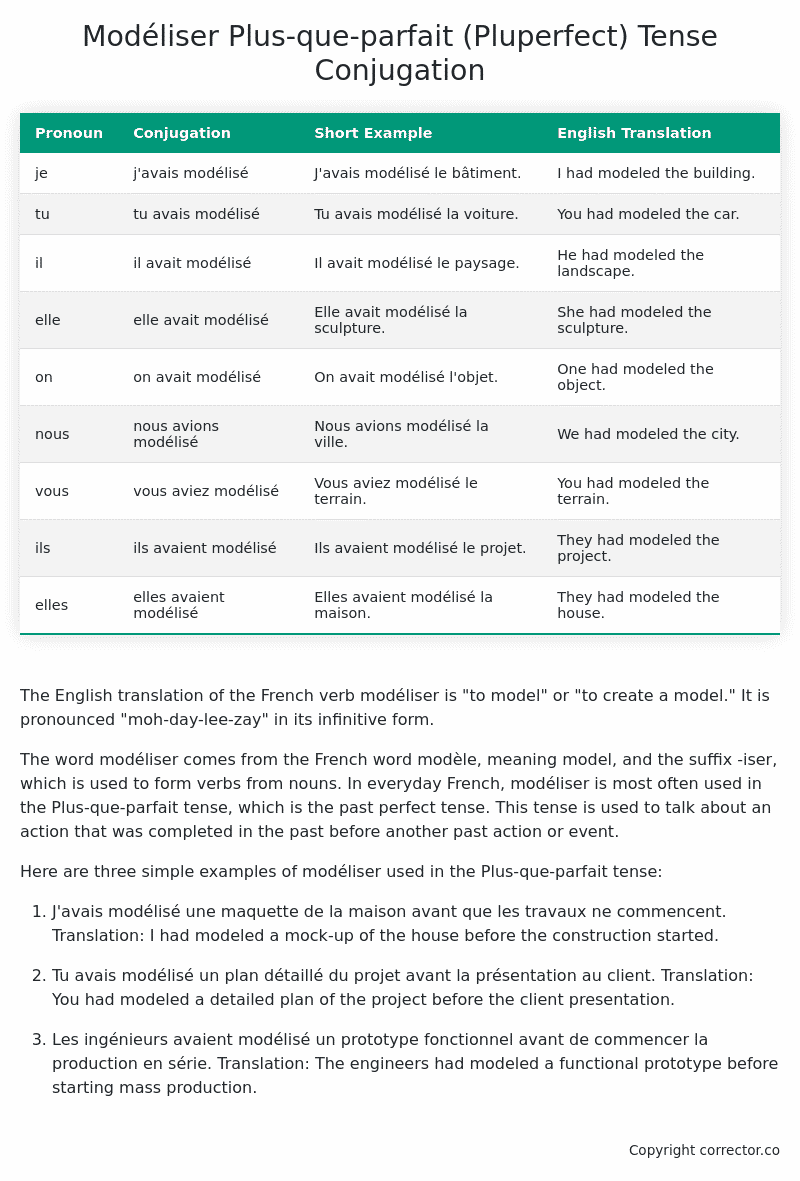Plus-que-parfait (Pluperfect) Tense Conjugation of the French Verb modéliser
Introduction to the verb modéliser
The English translation of the French verb modéliser is “to model” or “to create a model.” It is pronounced “moh-day-lee-zay” in its infinitive form.
The word modéliser comes from the French word modèle, meaning model, and the suffix -iser, which is used to form verbs from nouns. In everyday French, modéliser is most often used in the Plus-que-parfait tense, which is the past perfect tense. This tense is used to talk about an action that was completed in the past before another past action or event.
Here are three simple examples of modéliser used in the Plus-que-parfait tense:
-
J’avais modélisé une maquette de la maison avant que les travaux ne commencent.
Translation: I had modeled a mock-up of the house before the construction started. -
Tu avais modélisé un plan détaillé du projet avant la présentation au client.
Translation: You had modeled a detailed plan of the project before the client presentation. -
Les ingénieurs avaient modélisé un prototype fonctionnel avant de commencer la production en série.
Translation: The engineers had modeled a functional prototype before starting mass production.
Table of the Plus-que-parfait (Pluperfect) Tense Conjugation of modéliser
| Pronoun | Conjugation | Short Example | English Translation |
|---|---|---|---|
| je | j’avais modélisé | J’avais modélisé le bâtiment. | I had modeled the building. |
| tu | tu avais modélisé | Tu avais modélisé la voiture. | You had modeled the car. |
| il | il avait modélisé | Il avait modélisé le paysage. | He had modeled the landscape. |
| elle | elle avait modélisé | Elle avait modélisé la sculpture. | She had modeled the sculpture. |
| on | on avait modélisé | On avait modélisé l’objet. | One had modeled the object. |
| nous | nous avions modélisé | Nous avions modélisé la ville. | We had modeled the city. |
| vous | vous aviez modélisé | Vous aviez modélisé le terrain. | You had modeled the terrain. |
| ils | ils avaient modélisé | Ils avaient modélisé le projet. | They had modeled the project. |
| elles | elles avaient modélisé | Elles avaient modélisé la maison. | They had modeled the house. |
Other Conjugations for Modéliser.
Le Present (Present Tense) Conjugation of the French Verb modéliser
Imparfait (Imperfect) Tense Conjugation of the French Verb modéliser
Passé Simple (Simple Past) Tense Conjugation of the French Verb modéliser
Passé Composé (Present Perfect) Tense Conjugation of the French Verb modéliser
Futur Simple (Simple Future) Tense Conjugation of the French Verb modéliser
Futur Proche (Near Future) Tense Conjugation of the French Verb modéliser
Plus-que-parfait (Pluperfect) Tense Conjugation of the French Verb modéliser (this article)
Passé Antérieur (Past Anterior) Tense Conjugation of the French Verb modéliser
Futur Antérieur (Future Anterior) Tense Conjugation of the French Verb modéliser
Subjonctif Présent (Subjunctive Present) Tense Conjugation of the French Verb modéliser
Subjonctif Passé (Subjunctive Past) Tense Conjugation of the French Verb modéliser
Subjonctif Imparfait (Subjunctive Imperfect) Tense Conjugation of the French Verb modéliser
Subjonctif Plus-que-parfait (Subjunctive Pluperfect) Tense Conjugation of the French Verb modéliser
Conditionnel Présent (Conditional Present) Tense Conjugation of the French Verb modéliser
Conditionnel Passé (Conditional Past) Tense Conjugation of the French Verb modéliser
L’impératif Présent (Imperative Present) Tense Conjugation of the French Verb modéliser
L’infinitif Présent (Infinitive Present) Tense Conjugation of the French Verb modéliser
Struggling with French verbs or the language in general? Why not use our free French Grammar Checker – no registration required!
Get a FREE Download Study Sheet of this Conjugation 🔥
Simply right click the image below, click “save image” and get your free reference for the modéliser Plus-que-parfait tense conjugation!

Modéliser – About the French Plus-que-parfait (Pluperfect) Tense
Tense Formation
Common everyday usage patterns
Sequencing of past events
Background information
Hypothetical or reported speech
Interactions with other tenses
Summary
I hope you enjoyed this article on the verb modéliser. Still in a learning mood? Check out another TOTALLY random French verb conjugation!


